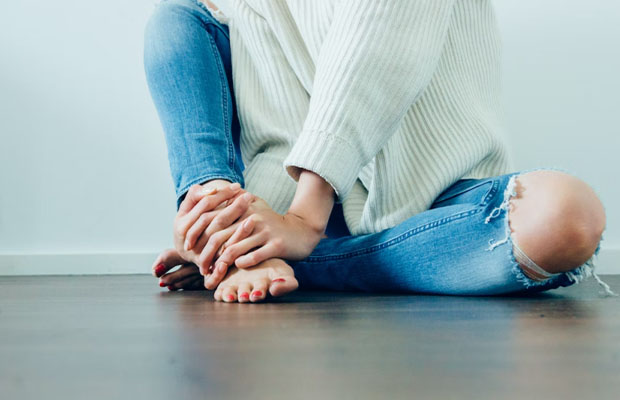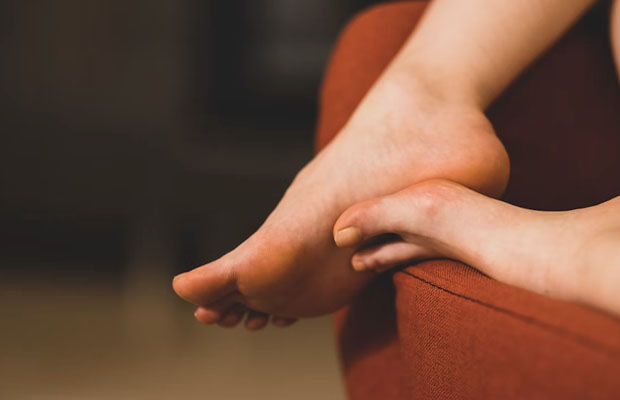Bump On Top Of Foot – Symptoms, Causes, and Treatment

Many people have trouble with the foot bump on top of the foot.
Injuries can result in transient swelling. But if there isn’t a clear reason, the bump might be a sign of something else.
The following are the two most frequent reasons for lumps and bumps on the top of the foot:
- A bone spur on top of the foot called an exostosis (tends to be firm and non-movable)
- A soft fluid filled sack called a ganglion cyst
Learn more about the signs, causes, and treatments for a bump on the top of the foot by reading on.
Read More: How To Tell If You Have A Broken Foot?
Table of Contents
What Is The Bump On Top Of Foot?
Almost always, a bone spur is a culprit.
- Normal forces can cause a bone spur to develop.
- Friction between the midfoot bones is brought on by increased pressure and stress.
- Little spurs grow over the years and decades as a result of this bone friction.
- One of the most frequent locations for bone spurs is the top of the foot.
Symptoms Of Bump On Top Of Foot
The size, color, and hardness of bumps on the tops of the feet can vary depending on what caused them.
If you have a bump on your foot, you might notice:
- Pain or discomfort
- Stiffness
- Areas of rough skin, or calluses
- Swelling or flushing
- Difficulty wearing tight shoes
- Difficulty walking
But occasionally a bump can appear without any accompanying symptoms. A doctor can make a diagnosis by noting the appearance and sensation of the bump.

Causes Of Bump On Top Of Foot
More information on the potential causes of a bump on the top of the foot can be found in the sections that follow.
Ganglion Cyst
Ganglion cysts are painless, fluid-filled bumps that frequently develop close to tendons and joints, like those in the hands and feet.
A noticeable lump is frequently the only symptom. On the other hand, ganglion cysts can also result in pain if they press on a joint or burning or tingling if they press on a nerve.
A physical examination by a physician can identify a ganglion cyst.
A ganglion cyst frequently doesn’t require medical attention. The fluid may, however, be drained or removal surgery may be recommended if it is particularly large, painful, or restricts movement.
Bone Spur
Small, bony growths known as osteophytes or bone spurs are common in close proximity to injured joints. On the top of the foot, they may occasionally develop and become skin-visible.
Osteoarthritis is a frequent reason for bone spurs.
If you have a bone spur on your foot, you might notice:
- discomfort or pain from wearing shoes
- limited movement
- calluses or blisters around the affected area
With the aid of an X-ray, a doctor can identify bone spurs.
Acetaminophen (Tylenol), an over-the-counter (OTC) pain reliever, may help reduce pain or discomfort brought on by a bone spur. Managing the condition may ease any joint pain or stiffness if the spur is a result of arthritis.
Bunions
On the outside of the foot, typically at the base of the big toe, a bunion, also known as a hallux valgus, is a growth of bone. At the base of the little toe, smaller bunions, also known as “bunionettes,” can develop.
Young females and males can also develop the condition, but older females are more frequently affected.
Symptoms include:
- a bump on the foot
- a toe that is out of alignment and leans toward the other toes
- pain and swelling
- difficulty walking
- discomfort when wearing tight shoes
- calluses on or around the bunion
- symptoms that gradually worsen over time
A physical examination or an X-ray can be used by a doctor to identify bunions.
Among the nonsurgical options are:
- wearing looser shoes
- icing swollen areas
- padding the bunion
- wearing a toe splint while sleeping
- taking OTC pain medication
Additionally, having surgery can stop the development of a bunion. The bunion could, however, reappear in some circumstances.
Bursitis
Bursa are sacs filled with fluid that are located between the bones of a joint. Bones can move against each other thanks to them. Bursitis is the term for an inflammation of one of these sacs.
The Achilles tendon and the heel bone are separated by a bursa, which is only present in one foot.
Foot bursitis can cause the following symptoms:
- pain, especially when walking or running
- intense pain when standing on tiptoes
- warm, flushed skin
Bursitis can be treated with the following:
- wearing spacious shoes
- wearing padded socks and orthotics
- taking nonsteroidal anti-inflammatory medications (NSAIDs)
- undergoing physical therapy
- receiving cortisone injections
- having it drained
Sometimes excessive rubbing and strain on the Achilles tendon can result in bursitis. Bursitis may not recur if the underlying cause is treated.
Gout
A buildup of uric acid leads to gout, a type of arthritis. Sudden, intense pain is a common big toe symptom of gout. One joint at a time is typically affected by this condition.
Symptoms include:
- burning pain
- stiffness
- swelling
- flushing
- tenderness and warmth
A person is more likely to develop gout if they:
- are male
- have overweight
- drink alcohol
- eat a diet high in purines and fructose
- have diabetes, metabolic syndrome, heart disease, or poor kidney function
Physical examination, X-rays, and laboratory tests can all be used by a doctor to determine the presence of gout.
Gout flare-ups can be controlled and minimized by:
- taking OTC pain medications
- reaching a moderate weight
- drinking less alcohol
- eating a diet low in purines
- protecting the joints
- managing any other health conditions
Lipoma
A lipoma is an uncancerous fatty tissue growth that develops beneath the skin.
Typically, lipomas include
- soft and rubbery
- painless
- movable when pushed
Lipomas typically form on the bottom of the foot when they appear on the foot. On the body, a lipoma can manifest itself anywhere.
Unless they grow large, lipomas typically do not need treatment. In this case, a surgeon can take the lipoma out.
How To Treat Bump On Top Of Foot?
For the top of the foot bone spurs, our main treatment objectives are to:
- Reduce pressure on top of the foot by wearing deeper shoes. Numerous shoe brands come in deeper-than-average depths while still looking good. Here are our favorite extra-depth shoes.
- Have your shoes stretched over the bump. Learn how to stretch shoes here.
- Use orthotics to stop the two bones from jamming together. In addition to preventing the foot from collapsing, good arch supports also ease discomfort and lessen the chance of the bump growing larger. The most effective way to do this is to use specialized custom orthotics called “total contact orthotics”.
- Use pads to reduce pressure on the bump. We recommend using a long-lasting gel U-shaped pad to take pressure off of the bump.
- Steroid injection: An injection of cortisone may be used to treat an inflamed bursa that occasionally sits on top of the bone spur. The injection will be ineffective if the bump is solely bone-related.
If all conservative treatment fails then surgery is an option to remove the bone spur. Although surgery is frequently very successful, we can almost always treat this issue non-operatively. If your doctor has recommended surgery, contact us first for a second opinion.
When Should I See A Doctor?
Uncomfortable pain can result from a bump on the top of the foot. A person needs to see a doctor if they are having trouble walking or if the bump has affected their quality of life.
To discuss potential complications and rule out any underlying medical conditions, it is best to see a doctor if a bump on the top of the foot is growing bigger or more painful.
Conclusion
Because of the complexity of the feet’s structures, a bump on the top of the foot may develop as a result of a variety of different circumstances. The proper diagnosis and course of treatment can be suggested by a physician.
People may be able to manage their symptoms in the interim with over-the-counter painkillers, ice, and cozy shoes.
Tags: Bump On Top Of Foot